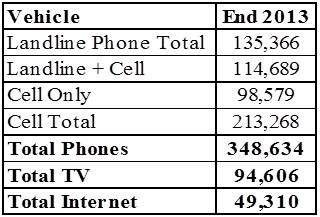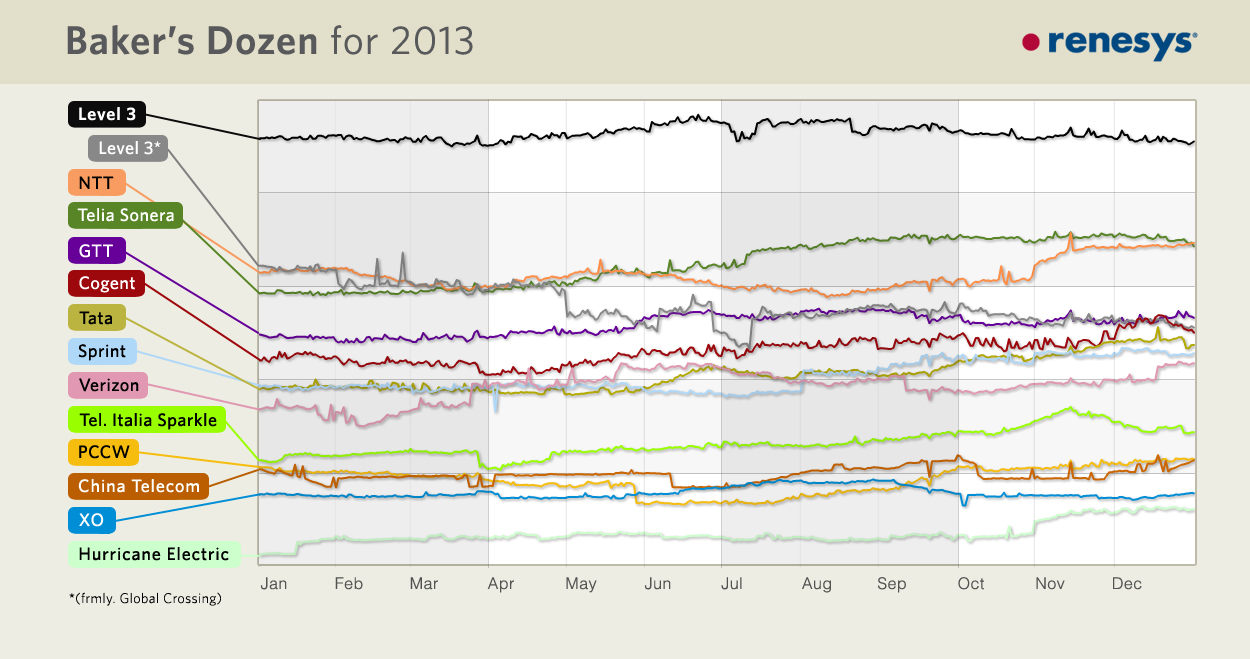Introduction
Chaos is too strong a term. But communication technologies are rapidly changing and significant regulatory changes are coming. And while humans get locked into habits, a growing number of Americans are opting out of their TV and landline phone contracts. Cell phones are taking over. And it is increasingly apparent that traditional mechanisms for TV delivery are outdated: do you really need to be provided with 200+ TV channels when you only watch 7? This article explains what has happened and what you should do.
The History of TV Technologies: a Consumer’s Perspective
TV started in the late ‘40’s with TV “ears” and “The Ed Sullivan Show”. Next came the roof antenna. In the late ‘80’s, I purchased a 12’ satellite dish and then cable. In 2005, I bought a Slingbox that allowed me to watch my home TV channels from anywhere in the world. And the FCC reports: “By December 2011, there were more than 5300 systems serving approximately 60 million subscribers in more than 34,000 communities.” And today, Roku and Apple (NASDAQ:AAPL) TV and other devices stream Internet to TV sets.
Background on the “Big 3” Communication Vehicles
Most US households communicate electronically via “Internet Service Providers (ISPs)” for three services: landline phones, TV, and Internet. Recently, cell phones have developed a huge market via separate contracts. Table 1 indicates there are now more cell phone contracts than landlines, and the latter continue to decline. There appear to be relatively few Internet contracts, but that is primarily because so many now get to the web via their cell phones.
Table 1. – US Communication Customers by Vehicle (1,000)

Source: Phone Data (households) – Centers for Disease Control, TV and Internet (contracts) – Leichtman Research Group
One more point on cell phones: we associate them with cell “towers”. But keep in mind that towers provide only the final link to/from the cell user. Like TV and the Internet, most cell phone traffic quickly moves from tower reception to cables. The following picture indicates the leading global cable provider companies, as measured by the quantity of “transited Internet provider space.”

Some of these companies are both carriers and providers to end users while others are just carriers. For example, Cogent manages over 57,900 route miles of intercity fiber and more than 27,400 metro fiber miles. It provides service to over 190 major markets and interconnect with over 5,130 other networks. But it is only an intermediary between providers with “end use” customers.
Table 2 provides data on ISP Internet contracts. The numbers continue to grow for all providers.
Table 2. – Internet Contracts by Leading Providers

The story for TV contracts is quite different. As Table 3 indicates, it has started to decline.
Table 3. – TV Contracts by Leading Providers

Now, while the decline is small, the so-called “cord-cutters” (those who have canceled their TV contracts) and “cord-neverings” (those who have never had TV contracts). The question of where this is all going much-discussed within the industry. The Sandvine Company has done some interesting research on what is happening. It defines “cord-cutters” as the group streaming the most audio and video via the Internet (top 15th percentile). Their steaming share of this group is extremely high – 72% of the total. Sandvine estimates this group watches roughly 100 hours of video per month via the Internet. It is reasonable to assume that many in this group do not have TV contracts but are watching TV via the web. In addition, this group probably plays video games online, a rapidly growing user of bandwidth.
Broadband Use
Broadband use is measured in two ways: by what is being sent (upstream) and by what is being received (downstream). These data are presented in Table 4. Netflix’s heavy use of broadband is notable. While not on this list, video games are “climbing up the charts.” For example, the video game live streaming service Twitch.TV (1.35%) now accounts for more traffic in the US than HBO GO (1.24%).
Table 4. – Top 10 Peak Period Applications – North America

What WILL “Net Neutrality” Mean?
In earlier times, the meaning of “net neutrality” was pretty straight forward – everyone on the Internet was treated equally, e.g., nobody could pay more to get faster service. But times have changed, and the FCC decided it needed to regulate ISPs. So it recently “redefined” ISPs as common carriers (like telephone companies). Then came its 400-page “new regs.” report. One thing is certain: there will be litigation and lots of it.
To give some sense of what is happening – Netflix Inc (NASDAQ:NFLX) dominance. The “spirit” of net neutrality is that all are treated equal – that no company can pay a carrier extra for “special services”. But can a carrier charge a company, such as Netflix, more for a huge amount of Broadband use? For example, we just learned that Netflix has agreed to pay Comcast (NASDAQ:CMCSA) “extra” for its heavy bandwidth use. Is this special treatment? A second example: Many cable and DSL providers considering implementing “usage based billing”. In North America, the top 1% of subscribers who make the heaviest use of the network’s upstream resources account for 47% of total upstream traffic. The comparable downstream users account for 12% of downstream bytes. At the opposite end of the usage spectrum, the network’s lightest 50% of users account for only 7% of total monthly traffic.
Will the FCC view such charges as a violation of net neutrality? Timothy Lee, who writes about Communication for the Washington Post, thinks so:
“Network neutrality advocates are going to have to go back to the drawing board…. Another [example of new issues comes from a dispute between the backbone provider Cogent Communications Group Inc (NASDAQ:CCOI) and Verizon Communications Inc (NYSE:VZ). Netflix is a Cogent customer. Surging Netflix traffic has been overwhelming the links between Cogent and Verizon. Cogent has asked for those links to be upgraded, but according to Cogent, Verizon has demanded payment for upgrading the links.”
Lee goes on: “…in a world where Netflix and Yahoo (NASDAQ:YHOO) connect directly to residential ISPs, every Internet company will have its own separate “pipe”. And policing whether different pipes are equally good is a much harder problem than requiring that all of the traffic in a single pipe be treated the same. If it wanted to ensure a level playing field, the FCC would be forced to become intimately involved in interconnection disputes, overseeing who Verizon interconnects with, how fast the connections are….”
Should You Give Up Your TV Contract?
I return to the question posed at the beginning of this article. Consider my (quite typical) TV uses. I regularly watch 7 TV channels for news, sports and entertainment. I also have a Roku and an Apple TV hooked up to different TVs so I can stream from the Web. Can I get all I need from the Web? Some channels stream directly from the Web. And even if they do not, one can access some past shows from the Web. But there are very few channels that allow you to stream live content unless it is from your current TV provider. My guess is that in return for payments from the ISPs, content providers are not allowed to offer their content via the Web. The only exception I have found is CBS – the CBS network’s shows are available live for $5.99 per month. In short, most content prodders will only offer what I have been able to get via Slingbox since 2005 – all the TV that I get through my current TV provider.
The Dish Network is trying something slightly different. In January, it launched “Sling TV, a stripped down” 16 channel package for $20 monthly. And you can pay to add additional channels. Undoubtedly, more changes are coming. But for now, I am not going to give up my TV contract to save $70 monthly. It is just too easy to turn on my TV and click on a channel. However, I will continue to call my ISP every two months and threaten to cancel my TV contract. It works well as a way to get my monthly payments reduced.
Investment Implications
The technologies in the communication industry are continually changing and set of new regulations will shortly be imposed. How likely is it that anyone will be able to anticipate what will happen next? Not very. For example, I cannot imagine the FCC will allow the merger of Comcast and Time Warner to go through: it would clearly reduce competition. But one should not underestimate their lobbying arms in DC. Open Secrets reports that the Communications Industry spent $381 million lobbying in DC last year.
For the record, Table 5 presents the price/earnings ratio for some of the leading communications companies. For reasons discussed above, I will not be investing in them in the foreseeable future.
Table 5. – Price Earnings Ratios for Selected Communications Companies

